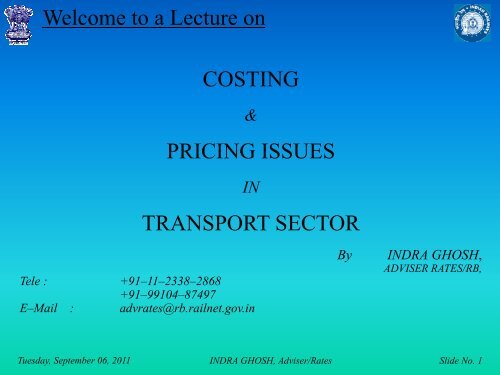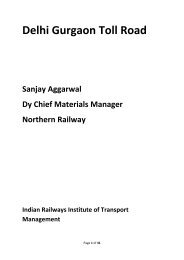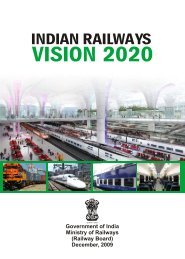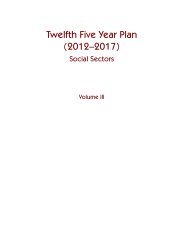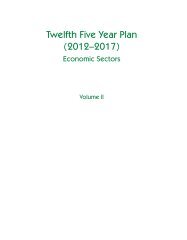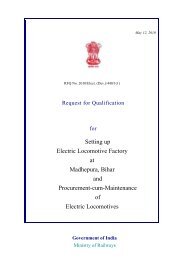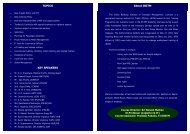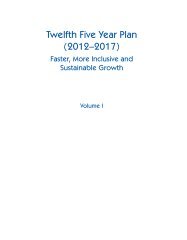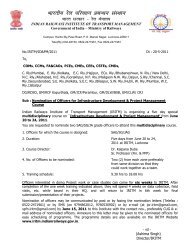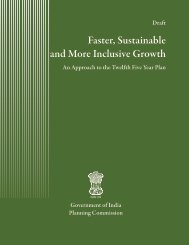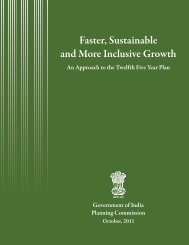Costing and Pricing Issues in Transport Sector - Indian Railways ...
Costing and Pricing Issues in Transport Sector - Indian Railways ...
Costing and Pricing Issues in Transport Sector - Indian Railways ...
Create successful ePaper yourself
Turn your PDF publications into a flip-book with our unique Google optimized e-Paper software.
Welcome to a Lecture on<br />
COSTING<br />
&<br />
PRICING ISSUES<br />
IN<br />
TRANSPORT SECTOR<br />
Tele : +91–11–2338–2868<br />
+91–99104–87497<br />
E–Mail : advrates@rb.railnet.gov.<strong>in</strong><br />
By<br />
INDRA GHOSH,<br />
ADVISER RATES/RB,<br />
Tuesday, September 06, 2011 INDRA GHOSH, Adviser/Rates Slide No. 1
DISCLAIMER<br />
Views expressed <strong>in</strong> this lecture are that<br />
of the speaker <strong>and</strong> may not necessarily<br />
reflect the official views of either<br />
Commercial Directorates of Railway<br />
Board or of the M<strong>in</strong>istryi of <strong>Railways</strong>.<br />
Tuesday, September 06, 2011 INDRA GHOSH, Adviser/Rates Slide No. 2
Outl<strong>in</strong>e of the Lecture<br />
• <strong>Indian</strong> Railway Act.<br />
• Functions of Rates Branch.<br />
• Cost of service & Vl Value of service.<br />
• Traditional Freight Structure.<br />
• Classification of Goods.<br />
• Freight rates for different classes.<br />
• Conta<strong>in</strong>er Tra<strong>in</strong> Operators.<br />
• Passenger Fares.<br />
Tuesday, September 06, 2011 INDRA GHOSH, Adviser/Rates Slide No. 3
Outl<strong>in</strong>e of the Lecture<br />
• <strong>Indian</strong> Railway Act.<br />
• Functions of Rates Branch.<br />
• Cost of service & Vl Value of service.<br />
• Traditional Freight Structure.<br />
• Classification of Goods.<br />
• Freight rates for different classes.<br />
• Conta<strong>in</strong>er Tra<strong>in</strong> Operators.<br />
• Passenger Fares.<br />
Tuesday, September 06, 2011 INDRA GHOSH, Adviser/Rates Slide No. 4
• <strong>Indian</strong> Railway Act.<br />
Outl<strong>in</strong>e of the Lecture<br />
Tuesday, September 06, 2011 INDRA GHOSH, Adviser/Rates Slide No. 5
<strong>Indian</strong> Railway Act<br />
• Railway Act 1989.<br />
• Chapter VI deals with Fixation of Rates.<br />
• Section 30 (1)<br />
• The Central Government* may<br />
– from time to time,<br />
– by general or special order fix,<br />
– for the carriageofpassengers g <strong>and</strong> goods,<br />
– rates for the whole or any part of the railway.<br />
– Different rates may be fixed for different classes of<br />
goods, <strong>and</strong><br />
– specify <strong>in</strong> such order the conditions subject to which<br />
such rates shall apply.<br />
Tuesday, September 06, 2011 INDRA GHOSH, Adviser/Rates Slide No. 6
<strong>Indian</strong> Railway Act<br />
• Section 30 (2).<br />
• The Central Government may by a like order,<br />
– fix the rates of any other charges <strong>in</strong>cidentalid to or<br />
connected with such carriage,<br />
– <strong>in</strong>clud<strong>in</strong>g demurrage <strong>and</strong> wharfage,<br />
– for the whole or any part of the railway, <strong>and</strong><br />
– specify <strong>in</strong> the order the conditions,<br />
– subject to which such rates shall apply.<br />
Tuesday, September 06, 2011 INDRA GHOSH, Adviser/Rates Slide No. 7
<strong>Indian</strong> Railway Act<br />
• Section 31<br />
• The Central Government shall have power to :<br />
– () (a) classify orreclassify anycommodity for the<br />
purpose of determ<strong>in</strong><strong>in</strong>g the rates to be charged for the<br />
carriage of such commodities.<br />
– (b) <strong>in</strong>crease or reduce the class rates <strong>and</strong> other<br />
charges.<br />
Tuesday, September 06, 2011 INDRA GHOSH, Adviser/Rates Slide No. 8
<strong>Indian</strong> Railway Act<br />
• Section 32<br />
• Notwithst<strong>and</strong><strong>in</strong>g anyth<strong>in</strong>g said <strong>in</strong> this Chapter, a railway<br />
adm<strong>in</strong>istration* i ti may,<br />
– <strong>in</strong> respect of the carriage of any commodity, <strong>and</strong><br />
– subject to such conditions as may be specified;<br />
– (a) quote a station to station rate,<br />
– (b) <strong>in</strong>crease or reduce or cancel a station to<br />
station rate,<br />
– (c) withdraw, alter or amend the conditions<br />
attached hdto a station to station rate, <strong>and</strong><br />
– (d) charge any lump sum rate.<br />
Tuesday, September 06, 2011 INDRA GHOSH, Adviser/Rates Slide No. 9
<strong>Indian</strong> Railway Act<br />
• As per Section 32, power of the Zonal Railway is<br />
limited only to quot<strong>in</strong>g of station to station rates.<br />
• However, noth<strong>in</strong>g <strong>in</strong> the Ril Railway At Act prevents the<br />
Central Government from delegat<strong>in</strong>g any of the powers<br />
<strong>in</strong> respect of Sections 30, 31 <strong>and</strong> 32 to Zonal <strong>Railways</strong>.<br />
• Either some or even all of them can be delegated.*<br />
• It’s a different matter that Zonal <strong>Railways</strong> don’t want<br />
these powers to be delegated.*<br />
• Central Government means M<strong>in</strong>istry of <strong>Railways</strong>.<br />
• Railway Board isaseparateentity.* i • Discharg<strong>in</strong>g of dual function.*<br />
• Defence M<strong>in</strong>istry <strong>and</strong> Army Hdqrts.<br />
• Example of other countries.*<br />
Tuesday, September 06, 2011 INDRA GHOSH, Adviser/Rates Slide No. 10
<strong>Indian</strong> Railway Act<br />
• Section 70.<br />
– A railway adm<strong>in</strong>istration shall not make any or give<br />
any undue or unreasonable preference or advantage<br />
to,<br />
– <strong>in</strong> favour of any particular person or any particular<br />
description of traffic <strong>in</strong> the carriage of goods.<br />
Tuesday, September 06, 2011 INDRA GHOSH, Adviser/Rates Slide No. 11
<strong>Indian</strong> Railway Act<br />
• Section 71 (1).*<br />
– The Central Government may if it is of the op<strong>in</strong>ion<br />
thatt it is necessary <strong>in</strong> the public <strong>in</strong>terest tto doso,<br />
– by general or special order, direct any railway<br />
adm<strong>in</strong>istration –<br />
Tuesday, September 06, 2011 INDRA GHOSH, Adviser/Rates Slide No. 12
<strong>Indian</strong> Railway Act<br />
– (a) to give special facilities for, or preference to,<br />
– carriage of such goods or class of goods consigned by<br />
or to<br />
– the Central Government or the Government of any<br />
State, or<br />
– of such other goods or class of goods.<br />
– (b) to carry such goods or class of goods by such<br />
route or routes <strong>and</strong> at such rates;<br />
– (c) to restrict or refuse acceptance of such goods<br />
or class of goodsatortosuch station of carriage,<br />
– as may be specified <strong>in</strong> that order.<br />
Tuesday, September 06, 2011 INDRA GHOSH, Adviser/Rates Slide No. 13
<strong>Indian</strong> Railway Act<br />
• Section 71.<br />
• (2) Any order made under sub-section (1) shall cease to<br />
have effect after the expiration of a period idof one year<br />
from the date of such order,<br />
– but may, by a like order,<br />
be renewed from time to<br />
time for such period not exceed<strong>in</strong>g one year at a time<br />
as may bespecified <strong>in</strong> the order.<br />
• (3) Every railway adm<strong>in</strong>istration shall be bound to<br />
comply with any order given under sub-section (1), <strong>and</strong><br />
– any action taken by a railway adm<strong>in</strong>istration i i <strong>in</strong><br />
pursuance of any such order shall not be deemed to<br />
be a contravention of section 70.*<br />
Tuesday, September 06, 2011 INDRA GHOSH, Adviser/Rates Slide No. 14
<strong>Indian</strong> Railway Act<br />
• Section 72.<br />
• (1) The gross weight of every wagon when loaded to its<br />
maximum carry<strong>in</strong>g capacity,<br />
– shall not exceed such limit as may be fixed by the<br />
Central Government.<br />
• (2) Subject to the limit fixed under sub – section (1),<br />
every railway adm<strong>in</strong>istration shall determ<strong>in</strong>e the normal<br />
carry<strong>in</strong>g capacity for every wagon.*<br />
Tuesday, September 06, 2011 INDRA GHOSH, Adviser/Rates Slide No. 15
<strong>Indian</strong> Railway Act<br />
• Section 73.<br />
• Where a person loads goods <strong>in</strong> a wagon beyond its<br />
permissible ibl carry<strong>in</strong>g capacityasexhibited,<br />
– a railway adm<strong>in</strong>istration may, <strong>in</strong> addition to the<br />
freight <strong>and</strong> other charges,<br />
– recover from the consignor, the consignee or the<br />
endorsee, as the case may be,<br />
– charges by way of penalty at such rates, as may be<br />
prescribed, before the delivery of the goods.<br />
Tuesday, September 06, 2011 INDRA GHOSH, Adviser/Rates Slide No. 16
<strong>Indian</strong> Railway Act<br />
• Section 78.<br />
• Notwithst<strong>and</strong><strong>in</strong>g anyth<strong>in</strong>g conta<strong>in</strong>ed <strong>in</strong> the railway<br />
receipt, it the railway adm<strong>in</strong>istration i ti may, bf before the<br />
delivery of the consignment, have the right to<br />
– Re–measure measure, re–weigh or re–classify any<br />
consignment;<br />
– re–calculate the freight <strong>and</strong> other charges; <strong>and</strong><br />
• correct any other error or collect any amount that may<br />
have been omitted to be charged.<br />
Tuesday, September 06, 2011 INDRA GHOSH, Adviser/Rates Slide No. 17
Outl<strong>in</strong>e of the Lecture<br />
• <strong>Indian</strong> Railway Act.<br />
• Functions of Rates Branch.<br />
Tuesday, September 06, 2011 INDRA GHOSH, Adviser/Rates Slide No. 18
Functions of Rates Branch<br />
• Decision regard<strong>in</strong>g freight rates of different<br />
commodities is a centralized function of Central<br />
Government.<br />
• As per Railway Act this power vests only with M<strong>in</strong>istry<br />
of <strong>Railways</strong>.<br />
• Independent of M<strong>in</strong>istry of F<strong>in</strong>ance.<br />
• Railway Board need not go even to Parliament for<br />
<strong>in</strong>creas<strong>in</strong>g/decreas<strong>in</strong>g of railway freights.<br />
• This has been so legislated <strong>in</strong> order to ensure that there<br />
isuniformityif i of freight rates throughout h the country.<br />
• Historical background of company railways.*<br />
• Provides for better seamless operations as far as<br />
realization of freight charges are concerned.*<br />
Tuesday, September 06, 2011 INDRA GHOSH, Adviser/Rates Slide No. 19
Functions of Rates Branch<br />
• The first exception is <strong>in</strong> case of giv<strong>in</strong>g station to station<br />
rates by zonal railways.<br />
• The second exception is <strong>in</strong> caseof giv<strong>in</strong>g ii of rebates bt<br />
under specified laid down schemes, where powers have<br />
been delegated to Zonal <strong>Railways</strong>. *<br />
• In second case, maximum upper limits have been laid<br />
down for giv<strong>in</strong>g gof rebates.*<br />
• Zonal railways as also our customers prefer it to be that<br />
way.*<br />
Tuesday, September 06, 2011 INDRA GHOSH, Adviser/Rates Slide No. 20
Functions of Rates Branch<br />
• Rebates/Surcharges can either be across the board for all<br />
zonal railways, or<br />
– they could be for a particular zone.<br />
• Rebates/Surcharges can be :<br />
– either for all commodities or for a particular<br />
commodity.*<br />
– They could be eitherforaspecific period* or could<br />
be of a permanent nature*.<br />
– They could be either for certa<strong>in</strong> distances or across all<br />
distance boundaries.<br />
– For certa<strong>in</strong> streams of traffic.<br />
• Fact rema<strong>in</strong>s that all rat<strong>in</strong>g activity is conf<strong>in</strong>ed only to<br />
M<strong>in</strong>istry of <strong>Railways</strong>.<br />
Tuesday, September 06, 2011 INDRA GHOSH, Adviser/Rates Slide No. 21
Functions of Rates Branch<br />
• Subject list of TC/CR branch are as follows :<br />
– Research <strong>and</strong> review of freight rates, passenger fares,<br />
parcel rates.<br />
– Exam<strong>in</strong>e cost<strong>in</strong>g for freight, passenger <strong>and</strong> parcel<br />
services.<br />
– Collection/compilation of <strong>in</strong>formation <strong>and</strong> data for<br />
conduct<strong>in</strong>g studies on different aspects of commercial<br />
work<strong>in</strong>g <strong>and</strong> all other ancillary matters.<br />
– Formulation of new schemes <strong>and</strong> policies for<br />
maximiz<strong>in</strong>g i i railway earn<strong>in</strong>gs.<br />
– Review of exist<strong>in</strong>g rules to br<strong>in</strong>g <strong>in</strong> simplification,<br />
transparency <strong>and</strong> to reduce the work of field offices.<br />
Tuesday, September 06, 2011 INDRA GHOSH, Adviser/Rates Slide No. 22
Functions of Rates Branch<br />
– Conduct<strong>in</strong>g specific studies on commercial matters <strong>in</strong><br />
l<strong>in</strong>e with reports of various committees such as<br />
• Ril Railway Fare <strong>and</strong> Freight htCommittee <strong>and</strong><br />
• Rail Tariff Enquiry Committee etc.<br />
– Memor<strong>and</strong>um to the Board <strong>and</strong> Cab<strong>in</strong>et on proposals<br />
received from other M<strong>in</strong>istries for revision of rates <strong>in</strong><br />
respect of specific commodities.<br />
• Formulation of Budget Document – Proposals for<br />
adjustments <strong>in</strong> Freight Rates <strong>and</strong> Passenger Fares <strong>in</strong> the<br />
Railway Budget.*<br />
Tuesday, September 06, 2011 INDRA GHOSH, Adviser/Rates Slide No. 23
Functions of Rates Branch<br />
• Subject list of TC/R branch are as follows :<br />
– Freight Incentive Schemes.<br />
– All types of freight concessions.<br />
– Classification of goods.<br />
– Pack<strong>in</strong>g conditions of goods.<br />
– Miscellaneous charges.<br />
– Charges related to Port Trust.<br />
– <strong>Transport</strong> of relief materials to affected areas.<br />
– Chargeable weight for commodities.<br />
– Tra<strong>in</strong> loadbenefit.<br />
– Distance for charge, Inflation <strong>in</strong> distance for charge.<br />
– Re–weighment charges.<br />
– Clubb<strong>in</strong>g of consignment.<br />
Tuesday, September 06, 2011 INDRA GHOSH, Adviser/Rates Slide No. 24
Functions of Rates Branch<br />
• Subject list of TC – I branch are as follows :<br />
– Free time <strong>and</strong> demurrage <strong>and</strong> wharfage rules.<br />
– Sid<strong>in</strong>g & Shunt<strong>in</strong>g charges.<br />
– Through distance freight.<br />
– Military tariff rates.<br />
– Notified stations.<br />
– All India Eng<strong>in</strong>e Hour cost.<br />
– PCO <strong>in</strong> CRT.<br />
– Railway Rates Tribunal Rules.<br />
– Agreements relat<strong>in</strong>g to Port Trust.<br />
– Commercial aspects regard<strong>in</strong>g Indo – Pakistan, Indo<br />
– Bangladesh Indo – Nepal traffic.*<br />
Tuesday, September 06, 2011 INDRA GHOSH, Adviser/Rates Slide No. 25
Functions of Rates Branch<br />
– Rules for payment of freight – Paid, To – Pay,<br />
Prepayment conditions etc.<br />
– Rl Rules for dli delivery of goods.<br />
– Undercharges <strong>in</strong> freight.<br />
– Weighbridges.<br />
– Penalties for overload<strong>in</strong>g of wagons etc.<br />
– Wagon Registration Fees.<br />
– E – Payment of freight.<br />
– Work<strong>in</strong>g of goods sheds.<br />
– Rules for carriage of dangerous goods.<br />
– Notified stations.<br />
– Licens<strong>in</strong>g of railway l<strong>and</strong>.<br />
Tuesday, September 06, 2011 INDRA GHOSH, Adviser/Rates Slide No. 26
Outl<strong>in</strong>e of the Lecture<br />
• <strong>Indian</strong> Railway Act.<br />
• Functions of Rates Branch.<br />
• Cost of service & Vl Value of service.<br />
Tuesday, September 06, 2011 INDRA GHOSH, Adviser/Rates Slide No. 27
Cost of service & Value of service<br />
• There are two pr<strong>in</strong>ciples which ma<strong>in</strong>ly decide the<br />
fixation of railway rates namely :<br />
– Cost of service <strong>and</strong><br />
– Value of service.<br />
Tuesday, September 06, 2011 INDRA GHOSH, Adviser/Rates Slide No. 28
Cost of service & Value of service<br />
• Cost of service :<br />
– Such charges must <strong>in</strong> no case be less than the cost to<br />
the railway management of render<strong>in</strong>g the required<br />
service.<br />
– This should be the lower limit of the freight rate.<br />
• Value of service :<br />
– They must <strong>in</strong> no case be more than the value of the<br />
service to the customers.<br />
– This should be the upper limit of the freight rate.<br />
Tuesday, September 06, 2011 INDRA GHOSH, Adviser/Rates Slide No. 29
Cost of service & Value of service<br />
• Railway charges ought to be based on the cost <strong>in</strong>curred<br />
<strong>in</strong> render<strong>in</strong>g<br />
– either a particular service, or<br />
– the entire gamut of rail services.<br />
• For services like transportation conducted under<br />
monopolistic conditions, the ideal system of charg<strong>in</strong>g<br />
would be<br />
– to ascerta<strong>in</strong> the cost of each service rendered, <strong>and</strong><br />
– to allow a reasonable marg<strong>in</strong> of profit over <strong>and</strong> above<br />
that amount.<br />
• But such a basis is impossible as no one knows as to<br />
what is the exact cost of transportation.<br />
Tuesday, September 06, 2011 INDRA GHOSH, Adviser/Rates Slide No. 30
Cost of service & Value of service<br />
• This basis is difficult to implement, because it is<br />
impossible to ascerta<strong>in</strong> the cost of any railway services;<br />
– none of the fixed charges, <strong>and</strong><br />
– very few of the operat<strong>in</strong>g expenses can be assigned;<br />
– except rather arbitrarily to the various services. *<br />
• Railway cost be<strong>in</strong>g uncerta<strong>in</strong> <strong>and</strong> fluctuat<strong>in</strong>g, a rate<br />
based purely on the cost of service rendered will have no<br />
relation to the capacity of the commodity to bear it.<br />
• Thus it is difficult to f<strong>in</strong>d any positive, objective basis<br />
for a system of railway rates based on costs.<br />
Tuesday, September 06, 2011 INDRA GHOSH, Adviser/Rates Slide No. 31
Cost of service & Value of service<br />
• In addition to above, rates must be fixed <strong>in</strong> advance<br />
before the service is rendered, <strong>and</strong><br />
– cost can be known only after the service has been<br />
rendered;<br />
– that too only approximately.<br />
• Another problem is the system of jo<strong>in</strong>t costs.*<br />
• S<strong>in</strong>ce the railway system is used for diverse goods <strong>and</strong><br />
services, it is similar to a plant that makes multiple<br />
commodities <strong>and</strong> requires jo<strong>in</strong>t cost<strong>in</strong>g.*<br />
• It is impossibleibl tobase railway rates on the pr<strong>in</strong>ciple i of<br />
cost of transportation alone.<br />
• Cost is of secondary importance <strong>in</strong> any practical exercise<br />
for pric<strong>in</strong>g.<br />
Tuesday, September 06, 2011 INDRA GHOSH, Adviser/Rates Slide No. 32
Cost of service & Value of service<br />
• Follow<strong>in</strong>g are some of the factors that used to be taken<br />
<strong>in</strong>to consideration <strong>in</strong> determ<strong>in</strong><strong>in</strong>g the cost of service :<br />
– Loadability.<br />
– Susceptibility of the commodity to damage <strong>and</strong><br />
railway’s liability for claim compensation.<br />
– Special h<strong>and</strong>l<strong>in</strong>g or special type of wagons<br />
required.<br />
– Extent to which the commodity may cause damage<br />
to other commodities.<br />
– Quality <strong>and</strong> regularity of movement.<br />
– Empty haulage <strong>in</strong>volved <strong>in</strong> provid<strong>in</strong>g transport.<br />
Tuesday, September 06, 2011 INDRA GHOSH, Adviser/Rates Slide No. 33
Cost of service & Value of service<br />
• It is the value of service which determ<strong>in</strong>es the rail users<br />
ability to pay.<br />
– In case of goods, the ability to pay dependsd largelyl<br />
upon their value, <strong>and</strong><br />
– <strong>in</strong> case of passengers, it largely depends upon ntheir<br />
<strong>in</strong>comes.<br />
• If goods of small value <strong>and</strong> passengers with lower<br />
<strong>in</strong>comes are to be carried, low charges must be made.<br />
• This is why the ability to pay implies division of goods<br />
traffic <strong>in</strong>to classification i scales <strong>and</strong><br />
– passenger traffic <strong>in</strong>to different classes of traffic.<br />
Tuesday, September 06, 2011 INDRA GHOSH, Adviser/Rates Slide No. 34
Cost of service & Value of service<br />
• S<strong>in</strong>ce alternative means of transportation is available to<br />
rail users,<br />
– Ril <strong>Railways</strong> cannot charge up to the physical limitit of the<br />
rail user can bear; but<br />
– only up to the limit of what he is will<strong>in</strong>g to bear.<br />
Tuesday, September 06, 2011 INDRA GHOSH, Adviser/Rates Slide No. 35
Cost of service & Value of service<br />
• It is the pr<strong>in</strong>ciple of jo<strong>in</strong>t costs which justifies<br />
discrim<strong>in</strong>ation by the railways.<br />
• Commodities classified at higherh classes are made to pay<br />
not only their approximate share of general costs, but <strong>in</strong><br />
addition,<br />
– that share of the jo<strong>in</strong>t cost which the low rated<br />
commodities cannot afford to pay. py<br />
• Similarly, higher class passengers pay more because<br />
they can afford to pay more, <strong>and</strong><br />
– it will enable railways to carry second class<br />
passengers at lower fares.<br />
Tuesday, September 06, 2011 INDRA GHOSH, Adviser/Rates Slide No. 36
Cost of service & Value of service<br />
• Follow<strong>in</strong>g are some of the factors that are taken <strong>in</strong>to<br />
consideration <strong>in</strong> determ<strong>in</strong><strong>in</strong>g the value of service :<br />
– Vl Value of the commodity at the dest<strong>in</strong>ation as<br />
compared with the value at the orig<strong>in</strong>at<strong>in</strong>g station.<br />
– Competition from other modes of transportation.<br />
– Potential competition from new sources of<br />
production <strong>and</strong> new markets.<br />
– Classification of comparable <strong>and</strong> related<br />
commodities.<br />
Tuesday, September 06, 2011 INDRA GHOSH, Adviser/Rates Slide No. 37
Cost of service & Value of service<br />
• Studies <strong>in</strong> traffic cost<strong>in</strong>g <strong>and</strong> cost difference shows that<br />
– Average haulage cost per km. decl<strong>in</strong>es with distance.<br />
– Element of term<strong>in</strong>al cost rema<strong>in</strong>s the same<br />
irrespective of whether the traffic is short distance or<br />
long distance.<br />
• These two factors together prove that the pr<strong>in</strong>ciple of<br />
telescopicratesismostscientific<strong>and</strong> is justified on the<br />
basis of the fact that<br />
– Rail user has limited capacity to pay for long distance<br />
traffic.<br />
– It costs less to the railways to carry traffic for longer<br />
distances.<br />
Tuesday, September 06, 2011 INDRA GHOSH, Adviser/Rates Slide No. 38
Outl<strong>in</strong>e of the Lecture<br />
• <strong>Indian</strong> Railway Act.<br />
• Functions of Rates Branch.<br />
• Cost of service & Vl Value of service.<br />
• Traditional Freight Structure.<br />
Tuesday, September 06, 2011 INDRA GHOSH, Adviser/Rates Slide No. 39
Traditional Freight Structure<br />
• Country wide uniformity <strong>in</strong> tariff.<br />
• Uniform telescop<strong>in</strong>g of rates for all commodities.<br />
• No regional, directional, seasonal or segmental<br />
sensitivity.<br />
• Tenuous l<strong>in</strong>kage with <strong>in</strong>put costs.<br />
• Cross subsidization across various commodity groups.<br />
• Unlimited subsidization of losses on Passenger services.<br />
• Driven by imperatives of revenue generation.<br />
• Adjustments s <strong>in</strong> tariff arduous <strong>and</strong> time consum<strong>in</strong>g.<br />
• Averse to bus<strong>in</strong>ess decisions <strong>and</strong> steeped <strong>in</strong> straitjacket.<br />
• Oblivious to market conditions <strong>and</strong> bus<strong>in</strong>ess<br />
opportunities.<br />
Tuesday, September 06, 2011 INDRA GHOSH, Adviser/Rates Slide No. 40
Traditional Freight Structure<br />
• Ad hoc tariff adjustments with no comprehensive long<br />
term view.<br />
• Unable to respond effectively <strong>and</strong> timely to customer<br />
dem<strong>and</strong>s.<br />
Tuesday, September 06, 2011 INDRA GHOSH, Adviser/Rates Slide No. 41
Traditional Freight Structure<br />
• From the traditional freight structure IR gradually tried<br />
to move to more commercially based freight structure.<br />
• Introduce <strong>in</strong>tegrated tariff <strong>and</strong> <strong>in</strong>centive structure custom<br />
tailored for each major bus<strong>in</strong>ess stream – present <strong>and</strong><br />
potential.<br />
• Tariff should be based on <strong>in</strong>put costs <strong>and</strong> leverage<br />
railway’s strengths <strong>in</strong> long haul <strong>and</strong> bulk.<br />
• Reduce cross subsidization amongst commodity groups.<br />
• Elim<strong>in</strong>ate tariff l<strong>in</strong>es operat<strong>in</strong>g below cost.*<br />
• Move towards FAK rates as far as possible with only<br />
limited exceptions.<br />
Tuesday, September 06, 2011 INDRA GHOSH, Adviser/Rates Slide No. 42
Traditional Freight Structure<br />
• Quantum of cross subsidization of passenger bus<strong>in</strong>ess<br />
from freight segment should be explicit <strong>and</strong> transparent.<br />
• Comprehensive recast<strong>in</strong>g of tariff for military, postal<br />
traffic etc.<br />
• Long term goal for tariff structure rationalization should<br />
be spelt out.<br />
Tuesday, September 06, 2011 INDRA GHOSH, Adviser/Rates Slide No. 43
Traditional Freight Structure<br />
• Institutionalization of mechanisms for seasonal,<br />
regional, directional <strong>and</strong> other variations.<br />
• Introduce differential pric<strong>in</strong>g <strong>in</strong> the bulk segment to<br />
drive revenue growth.<br />
• Promote long term arrangements with corporate clients.<br />
• Promote growth of bus<strong>in</strong>ess volumes through negotiated<br />
packages.<br />
• Promote cargo aggregators <strong>and</strong> other new bus<strong>in</strong>ess<br />
streams sas potentially highrevenue segments.<br />
e s.<br />
• Enabl<strong>in</strong>g mechanisms for revenue maximization from<br />
idle assets <strong>and</strong> under utilized capacities with speedy<br />
offer of rates.<br />
Tuesday, September 06, 2011 INDRA GHOSH, Adviser/Rates Slide No. 44
Traditional Freight Structure<br />
• Miscellaneous charges.<br />
– Inflated distance for charge.<br />
– Charges for Port Trust <strong>Railways</strong>.<br />
– Charges for haulage of eng<strong>in</strong>es.<br />
– Surcharge for ‘To Pay’ traffic.<br />
Tuesday, September 06, 2011 INDRA GHOSH, Adviser/Rates Slide No. 45
Outl<strong>in</strong>e of the Lecture<br />
• <strong>Indian</strong> Railway Act.<br />
• Functions of Rates Branch.<br />
• Cost of service & Vl Value of service.<br />
• Traditional Freight Structure.<br />
• Classification of Goods.<br />
Tuesday, September 06, 2011 INDRA GHOSH, Adviser/Rates Slide No. 46
Classification of Goods<br />
• All commodities have been classified <strong>in</strong>to 16 different<br />
classes for the purpose of charg<strong>in</strong>g of freight.<br />
• Base class isclass 100.*<br />
• Lowest class whose freight is cheapest is LR – 4.<br />
– This is equivalent to class rate of 60.<br />
• Highest class whose freight is maximum is 200 for<br />
Petroleum products.*<br />
• All other commodities come somewhere <strong>in</strong> between.<br />
• Over the years railways have gradually reduced the<br />
number of classes from 59 to 15.<br />
• It has been attempted to fit all commodities <strong>in</strong>to one of<br />
these exist<strong>in</strong>g classes only.*<br />
Tuesday, September 06, 2011 INDRA GHOSH, Adviser/Rates Slide No. 47
Classification of Goods<br />
• Along with reduc<strong>in</strong>g the number of classes, the total<br />
number of commodities which have been so classified<br />
have also been reduced.<br />
d<br />
• Over the years railways have reduced the total number<br />
of classified commodities from over 4000 to only 21<br />
groups.<br />
• An over – rid<strong>in</strong>g clause stipulates that if any commodity<br />
does not figure <strong>in</strong> the list of commodities which have<br />
been classified,<br />
– then itshould ldbecharged at the highesth class rate.*<br />
• Type of wagon wise classification.*<br />
Tuesday, September 06, 2011 INDRA GHOSH, Adviser/Rates Slide No. 48
Classification of Goods<br />
• Logic given was that railways are simplify<strong>in</strong>g the freight<br />
structure <strong>and</strong> will be easier for customers to<br />
underst<strong>and</strong>. *<br />
• This reduction <strong>in</strong> number of commodities has been<br />
<strong>in</strong>correct.<br />
• After all if 4000 + number of commodities i were bi be<strong>in</strong>g<br />
transported by railways earlier,<br />
– then even today more or less the same number of<br />
commodities are likely to be transported.<br />
• There may have been some reduction <strong>in</strong> commodities<br />
due to block rake movement,* t*<br />
– but such reduction would have been maybe 20% –<br />
30% at the most.<br />
• It cannot justify such drastic reduction.<br />
Tuesday, September 06, 2011 INDRA GHOSH, Adviser/Rates Slide No. 49
Classification of Goods<br />
• As a result of number of classified commodities hav<strong>in</strong>g<br />
been reduced,<br />
– there are large number of commodities which h do not<br />
have any class at all.<br />
• Present rules stipulate that all of them are to be charged<br />
at a uniform class rate depend<strong>in</strong>g on type of wagon.<br />
• As a result of the above some of these commodities have<br />
moved to road.<br />
• Secondly, by reduc<strong>in</strong>g the number of classes from 59 to<br />
15, the gapbetween freight ratesof adjo<strong>in</strong><strong>in</strong>g i classes has<br />
substantially <strong>in</strong>creased.<br />
• Any change of class even by one step <strong>in</strong>creases the<br />
freight rate substantially.<br />
Tuesday, September 06, 2011 INDRA GHOSH, Adviser/Rates Slide No. 50
Classification of Goods<br />
• As of today the follow<strong>in</strong>g classes exist :<br />
• LR – 4 Bamboos, Coffee, Tea, Coir, Cotton.<br />
• LR – 3 Charcoal, Paper.<br />
• LR – 2 Fireworks.<br />
• LR – 1 Jute, Organic manure, Timber.<br />
• Class 100<br />
• Class 110<br />
Leather, Rubber & Plastic, Edible oil.<br />
De – oiled cake, Sugar, Salt.<br />
• Class 120<br />
Clay, Oil cake<strong>and</strong> Seeds, Flyash.<br />
• Class 130 Fertilizer*, Foodgra<strong>in</strong>*, Steel Pipes,<br />
Wire rod coils.<br />
Tuesday, September 06, 2011 INDRA GHOSH, Adviser/Rates Slide No. 51
• Class 140<br />
• Class 150<br />
• Class 160<br />
• Class 170<br />
• Class 180<br />
• Class 190 –<br />
• Class 200<br />
Classification of Goods<br />
Caustic Soda, Slag, Edible Oils.<br />
Cement*, Coal & Coke*, Cl<strong>in</strong>ker,<br />
Molasses, Gypsum, S<strong>and</strong> & Stones.<br />
M<strong>in</strong>erals & Ore, Metal scrap, Pig Iron.<br />
Bitumen.<br />
Iron Ore for domestic*, Alloys &<br />
Metals, Iron & Steel, LPG.<br />
Acids, Alcohol, Petroleum products.<br />
Tuesday, September 06, 2011 INDRA GHOSH, Adviser/Rates Slide No. 52
Classification of Goods<br />
• Chargeable carry<strong>in</strong>g capacity was made uniform with<br />
effect from 1.4.2005, <strong>and</strong><br />
– m<strong>in</strong>imum i weight condition was done away with.<br />
• Consignments carried <strong>in</strong> any type of wagon will be<br />
charged as per the Prescribed Carry<strong>in</strong>g Capacity (PCC)<br />
of that type of wagon.*<br />
• For example, earlier bamboo be<strong>in</strong>g a light commodity<br />
was charged for a m<strong>in</strong>imum weight of 22T.<br />
• As per the revised PCC, consignment of bamboo was<br />
charged for the fll full carry<strong>in</strong>g capacity of the BCN wagon<br />
at 63T.<br />
• This resulted <strong>in</strong> substantial amount of idle freight be<strong>in</strong>g<br />
paid for such light weight consignments.<br />
Tuesday, September 06, 2011 INDRA GHOSH, Adviser/Rates Slide No. 53
Classification of Goods<br />
• In order to compensate for the idle freight <strong>and</strong> reduce the<br />
same to a large extent,<br />
– the classification of light weight ihtcommodities was<br />
reduced <strong>in</strong> number of cases,<br />
– <strong>in</strong> order to br<strong>in</strong>g down the overall freight.<br />
Tuesday, September 06, 2011 INDRA GHOSH, Adviser/Rates Slide No. 54
Classification of Goods<br />
• Previous/revised chargeable weight <strong>and</strong> class :<br />
Previous<br />
Revised<br />
Commodity MWC Class PCC Class<br />
Bamboo 22 145 63 LR – 4<br />
Charcoal 34 130 63 LR – 3<br />
Coir 12 190 63 LR – 4<br />
Jute 30 160 63 LR – 1<br />
Tuesday, September 06, 2011 INDRA GHOSH, Adviser/Rates Slide No. 55
Outl<strong>in</strong>e of the Lecture<br />
• <strong>Indian</strong> Railway Act.<br />
• Functions of Rates Branch.<br />
• Cost of service & Vl Value of service.<br />
• Traditional Freight Structure.<br />
• Classification of Goods.<br />
• Freight rates for different classes.<br />
Tuesday, September 06, 2011 INDRA GHOSH, Adviser/Rates Slide No. 56
Freight rates for different classes<br />
• Railway Board publishes a freight rate table which gives<br />
– class wise freight rate,<br />
– per tonne,<br />
– for different distance slabs.<br />
• It is a historical table <strong>and</strong> has been exist<strong>in</strong>g s<strong>in</strong>ce times<br />
immemorial.*<br />
• Over the years it has undergone only m<strong>in</strong>or cosmetic<br />
changes,<br />
– without any major changes hav<strong>in</strong>g been attempted.<br />
• There isataperwith ih<strong>in</strong>creas<strong>in</strong>gi distance,<br />
– which is the same for all commodities <strong>in</strong> that class.<br />
Tuesday, September 06, 2011 INDRA GHOSH, Adviser/Rates Slide No. 57
Freight rates for different classes<br />
Freight/tonne for different classes <strong>and</strong> distance slabs<br />
Distance/Class<br />
100 120 140 160 180<br />
201 – 210 147 176 205 235 264<br />
301 – 310 202 243 283 324 364<br />
401 – 410 258 309 361 412 464<br />
801 – 825 494 593 692 790 889<br />
1201 – 1225 719 863 1007 1151 1295<br />
1501 – 1525 887 1064 1241 1419 1596<br />
1801 – 1825 1033 1240 1446 1653 1859<br />
Tuesday, September 06, 2011 INDRA GHOSH, Adviser/Rates Slide No. 58
Freight rates for different classes<br />
• Rates for different classes are modified based on<br />
– whether the rate is to be <strong>in</strong>creased or decreased.<br />
• Themarg<strong>in</strong>al adjustmentsaredone t d depend<strong>in</strong>gdi<br />
on<br />
– whether same has been <strong>in</strong>creased or reduced <strong>in</strong> the<br />
last couple of years, <strong>and</strong><br />
– our perception of what the traffic can bear.<br />
• No exercise has been done of mak<strong>in</strong>g an ab-<strong>in</strong>itio<br />
analysis of the cost of operation <strong>and</strong> for fix<strong>in</strong>g of rates<br />
accord<strong>in</strong>gly.*<br />
• In most cases it is not only difficult but impossible.* ibl • Cost of haul<strong>in</strong>g a foodgra<strong>in</strong> rake <strong>and</strong> a cement rake is<br />
the same,<br />
– but they cannot be charged equally.*<br />
Tuesday, September 06, 2011 INDRA GHOSH, Adviser/Rates Slide No. 59
Freight rates for different classes<br />
• There are two ways of chang<strong>in</strong>g the freight rates.<br />
• 1 st method is to change the base freight rate of class 100<br />
at distance slab lb1 – 100 kms.<br />
– Thereafter base freight rate of class 100 across all<br />
distance slabs will get changed automatically,<br />
as per the distance multiplication scale.<br />
– This is Static Rat<strong>in</strong>g.*<br />
• 2 nd method is change the freight rate of a particular<br />
commodity without disturb<strong>in</strong>g the freight rates of other<br />
commodities.<br />
i<br />
– This is Dynamic Rat<strong>in</strong>g.*<br />
Tuesday, September 06, 2011 INDRA GHOSH, Adviser/Rates Slide No. 60
Freight rates for different classes<br />
• Theoretically, there are two ways of chang<strong>in</strong>g the freight<br />
rate of any commodity.<br />
• In casefreight rate of a particular commodity is to be<br />
<strong>in</strong>creased, then the same can be done<br />
– either by <strong>in</strong>creas<strong>in</strong>g the freight rate for that class,<br />
<strong>in</strong> which case freight rate of all commodities <strong>in</strong><br />
that class will be uniformly <strong>in</strong>creased; or<br />
– alternatively, the classification of that particular<br />
commodity can be <strong>in</strong>creased,<br />
– so that the change does not effect any other<br />
commodity.<br />
Tuesday, September 06, 2011 INDRA GHOSH, Adviser/Rates Slide No. 61
Freight rates for different classes<br />
• Each class has an exact relationship to base class 100.<br />
• Hence, it is not possible to t<strong>in</strong>ker with the class rate of a<br />
particular class, say class 120, without t disturb<strong>in</strong>g thatt<br />
exact relationship.<br />
– alternatively, the classification of that particular<br />
commodity can be <strong>in</strong>creased,<br />
• Therefore, the only way of chang<strong>in</strong>g g the freight rate of a<br />
particular commodity is by chang<strong>in</strong>g its classification.*<br />
• With reduced number of classes, even change of one<br />
step from class 100 to class 110 implies an <strong>in</strong>crease of<br />
10%, <strong>and</strong><br />
– from class 190 to class 200 implies an <strong>in</strong>crease of<br />
5.26%.<br />
Tuesday, September 06, 2011 INDRA GHOSH, Adviser/Rates Slide No. 62
Freight rates for different classes<br />
• This is the ma<strong>in</strong> drawback of reduced number of classes.<br />
• Logic given was that railways are simplify<strong>in</strong>g the freight<br />
structure t <strong>and</strong> it is easier for customers tounderst<strong>and</strong>.*<br />
t d*<br />
• No customer deals <strong>in</strong> fifteen different commodities.<br />
• Neither do they deal over vary<strong>in</strong>g distances.<br />
• Most of them deal with select few commodities <strong>and</strong> they<br />
are aware of the classification of their own commodities.<br />
• Similarly, their traffic does not go all over the country to<br />
hundreds of dest<strong>in</strong>ations.<br />
– there are select few dest<strong>in</strong>ations i to which h their hi<br />
consignment is despatched, <strong>and</strong><br />
– all customers know the freight rates to those<br />
dest<strong>in</strong>ations.<br />
Tuesday, September 06, 2011 INDRA GHOSH, Adviser/Rates Slide No. 63
Freight rates for different classes<br />
• Another reason given was that by simplify<strong>in</strong>g the freight<br />
structure it will be easier for field staff to underst<strong>and</strong>.*<br />
• When a customer comes to book his consignment the<br />
CGS first checks up Goods Tariff, Part I (Vol. II), which<br />
is the book of classification <strong>in</strong> order to<br />
– verify the class of that commodity;<br />
– let us say the commodity class is 140.<br />
• Thereafter the CGS will calculate the distance from the<br />
orig<strong>in</strong>at<strong>in</strong>g to the dest<strong>in</strong>ation station,<br />
– us<strong>in</strong>g thethrough h hdistance <strong>and</strong><br />
– the junction distance tables.<br />
• Let us say the distance comes to 763 kms.<br />
Tuesday, September 06, 2011 INDRA GHOSH, Adviser/Rates Slide No. 64
Freight rates for different classes<br />
• CGS will lastly open the freight rate table <strong>and</strong> check up<br />
the freight rate per tonne for class rate 140 at the<br />
distance slab lbof 760 – 770 kms. distance.*<br />
• The freight rate at Class 140 for distance of 763 Kms.<br />
comes to Rs. 648.10/tonne.<br />
• Hav<strong>in</strong>g obta<strong>in</strong>ed the freight rate/tonne he f<strong>in</strong>ally<br />
multiplies the freight rate/tonne with the total load of the<br />
rake to arrive at the total freight.<br />
• Let us say the total weight of the consignment comes to<br />
2450 tonnes.<br />
• So the total freight is worked out as<br />
– Rs. 648.10 x 2450 = Rs. 15,87,845/-<br />
845/<br />
• This is the complete cycle.<br />
Tuesday, September 06, 2011 INDRA GHOSH, Adviser/Rates Slide No. 65
Freight rates for different classes<br />
• In this entire cycle the follow<strong>in</strong>g activities are common<br />
irrespective of whatever may be the class of the<br />
commodity;<br />
– Goods Tariff, Part I (Vol. II).<br />
– Through Distance table, <strong>and</strong><br />
– Junction distance table.<br />
– Freight rate table.*<br />
• Even <strong>in</strong> this he has to f<strong>in</strong>ally consult a table,<br />
– Whether there are 15 columns <strong>in</strong> that table or 30<br />
columns is immaterial. i • The CGS has to see one column <strong>and</strong> one row <strong>in</strong> that<br />
table.<br />
Tuesday, September 06, 2011 INDRA GHOSH, Adviser/Rates Slide No. 66
Freight rates for different classes<br />
• As far as the CGS is concerned his workload rema<strong>in</strong>s the<br />
same.<br />
• With FOIS th<strong>in</strong>gs have now become much easier.<br />
• No CGS deals <strong>in</strong> fifteen different commodities.*<br />
• Most of them deal with select few commodities <strong>and</strong> they<br />
are aware of the classification of their own commodities.<br />
• Neither do they deal over vary<strong>in</strong>g distances.<br />
• Traffic booked from specific goods shed does not go all<br />
over the country to hundreds of dest<strong>in</strong>ations.<br />
– there are select few dest<strong>in</strong>ations i to which<br />
h<br />
consignment from each goods shed is despatched.<br />
• All CGSs know the freight rates to those dest<strong>in</strong>ations.*<br />
Tuesday, September 06, 2011 INDRA GHOSH, Adviser/Rates Slide No. 67
Freight rates for different classes<br />
• By reduc<strong>in</strong>g the total number of different commodities,<br />
which have been classified, from 4000 + to 21 groups,<br />
<strong>and</strong><br />
– by reduc<strong>in</strong>g the overall number of classes from 59 to<br />
16;<br />
• <strong>Railways</strong> have made it practically impossible to change<br />
the freight of an <strong>in</strong>dividual commodity without chang<strong>in</strong>g<br />
g<br />
its classification.<br />
• Perhaps the officials who undertook that exercise did not<br />
realize the implications i of their hi action.<br />
• Wanted to ga<strong>in</strong> easy kudos.*<br />
Tuesday, September 06, 2011 INDRA GHOSH, Adviser/Rates Slide No. 68
Freight rates for different classes<br />
• Comparison with the Wholesale Price Index (WPI)<br />
which measures the annual <strong>in</strong>flation gives a good idea of<br />
thechangeh <strong>in</strong> freight ratevis-à-vis i the WPI.<br />
• Data has been collected for display<strong>in</strong>g changes <strong>in</strong> freight<br />
rate of 7 important commodities over last 15 years.<br />
• The commodities selected are :<br />
– Food Gra<strong>in</strong>.<br />
– Fertilizer.<br />
– Coal.<br />
– HSD.<br />
– Cement.<br />
– Iron & Steel.<br />
– Other Goods, which is basically a mixed basket.<br />
Tuesday, September 06, 2011 INDRA GHOSH, Adviser/Rates Slide No. 69
Increase <strong>in</strong> Foodgra<strong>in</strong> freight (1177 kms)<br />
300<br />
259<br />
% Incr ease ><br />
200<br />
100<br />
229<br />
216 246<br />
206<br />
196 227 227 227<br />
187<br />
156 161 167 176 185<br />
141 145 166 166 166<br />
133<br />
122<br />
127 155 155 155<br />
149 149<br />
113 142<br />
100<br />
100<br />
1993<br />
109 109<br />
1995<br />
1997<br />
1999<br />
2001<br />
Years<br />
2003<br />
2005<br />
WPI<br />
Foodgra<strong>in</strong><br />
2007<br />
2009<br />
Tuesday, September 06, 2011 INDRA GHOSH, Adviser/Rates Slide No. 70
Increase <strong>in</strong> Fertilizer freight (825 kms)<br />
300<br />
259<br />
% Incr ease ><br />
200<br />
100<br />
122<br />
113<br />
100<br />
100<br />
1993<br />
104 104 104<br />
1995<br />
229<br />
216<br />
206<br />
196 227<br />
187<br />
156 161 167 176 141 145 161 166 175 175 175<br />
133<br />
164 164 164<br />
127<br />
1997<br />
135 135 140 161 164 164 164<br />
WPI<br />
1999<br />
2001<br />
Years<br />
142<br />
2003<br />
2005<br />
2007<br />
Fertilizer<br />
Tuesday, September 06, 2011 INDRA GHOSH, Adviser/Rates Slide No. 71<br />
2009
Increase <strong>in</strong> Coal freight (611 kms)<br />
300<br />
259<br />
% Incr ease ><br />
200<br />
100<br />
100<br />
229<br />
216<br />
206<br />
187<br />
196<br />
156 161 167 176 141 145 182<br />
167 167<br />
133<br />
170 170 170<br />
122<br />
127<br />
113 142 142 148 151 154 155 155<br />
123<br />
112 100 104<br />
1993<br />
1995<br />
1997<br />
1999<br />
2001<br />
Years<br />
2003<br />
2005<br />
WPI<br />
Coal<br />
2007<br />
2009<br />
Tuesday, September 06, 2011 INDRA GHOSH, Adviser/Rates Slide No. 72
Increase <strong>in</strong> HSD Freight (640 kms)<br />
300<br />
259<br />
% Incr ease ><br />
200<br />
100<br />
100<br />
100<br />
1993<br />
113<br />
229<br />
216<br />
206<br />
187<br />
196<br />
156 161 167 176 141 145 133<br />
122<br />
127<br />
149 149 155 158 163 160<br />
157<br />
148 148 148<br />
138<br />
132<br />
126<br />
113 121 133<br />
1995<br />
1997<br />
1999<br />
WPI<br />
2001<br />
Years<br />
2003<br />
2005<br />
2007<br />
HSD<br />
Tuesday, September 06, 2011 INDRA GHOSH, Adviser/Rates Slide No. 73<br />
2009
Increase <strong>in</strong> Cement freight (561 kms)<br />
300<br />
259<br />
% Incr ease ><br />
200<br />
100<br />
229<br />
216<br />
206<br />
187<br />
196<br />
156 161 167 176 141 145 168<br />
133<br />
122<br />
127<br />
113 144 147 150 154 154 154 154 157 157 157<br />
148 141<br />
100 129<br />
117<br />
100 109<br />
1993<br />
1995<br />
1997<br />
1999<br />
2001<br />
Years<br />
Tuesday, September 06, 2011 INDRA GHOSH, Adviser/Rates Slide No. 74<br />
2003<br />
2005<br />
2007<br />
WPI<br />
Cement<br />
2009
Increase <strong>in</strong> I&S Freight (1006 kms)<br />
300<br />
259<br />
% Incr ease ><br />
200<br />
100<br />
100<br />
229<br />
216<br />
206<br />
187<br />
196<br />
156 161 167 176 141 145 133<br />
122<br />
127<br />
113<br />
125 128 126 131 133 136 130 124 124 124 126 126 126 126<br />
114 100 106<br />
1993<br />
1995<br />
1997<br />
1999<br />
2001<br />
Years<br />
Tuesday, September 06, 2011 INDRA GHOSH, Adviser/Rates Slide No. 75<br />
2003<br />
2005<br />
2007<br />
WPI<br />
Iron & Steel<br />
2009
Increase <strong>in</strong> Other Goods (830 kms)<br />
300<br />
259<br />
% Incr ease ><br />
200<br />
100<br />
100<br />
229<br />
216<br />
206<br />
187<br />
196<br />
156 161 167 176 141 145 133<br />
122<br />
127<br />
113 138 138 143 150 155 152 152 152 152 155 155 155 155<br />
123<br />
112 100 104<br />
1993<br />
1995<br />
1997<br />
1999<br />
2001<br />
Years<br />
2003<br />
2005<br />
WPI<br />
Other Goods<br />
2007<br />
2009<br />
Tuesday, September 06, 2011 INDRA GHOSH, Adviser/Rates Slide No. 76
Outl<strong>in</strong>e of the Lecture<br />
• <strong>Indian</strong> Railway Act.<br />
• Functions of Rates Branch.<br />
• Cost of service & Vl Value of service.<br />
• Traditional Freight Structure.<br />
• Classification of Goods.<br />
• Freight rates for different classes.<br />
• Conta<strong>in</strong>er Tra<strong>in</strong> Operators.<br />
Tuesday, September 06, 2011 INDRA GHOSH, Adviser/Rates Slide No. 77
Conta<strong>in</strong>er Tra<strong>in</strong> Operators<br />
• In 2006 runn<strong>in</strong>g of conta<strong>in</strong>er tra<strong>in</strong>s was thrown open to<br />
private sector.<br />
• Prospective operators were required to register it<br />
themselves with IR <strong>and</strong> pay a licence fee.<br />
• There were two categories of Licence Fees.<br />
– 50 Crs. for operat<strong>in</strong>g between NCR <strong>and</strong> JNPT.<br />
– 10 Crs. for other sectors.<br />
• Licenses were granted to 14 Private Conta<strong>in</strong>er Operators<br />
(PCOs) for runn<strong>in</strong>g their own tra<strong>in</strong>s<br />
– by pay<strong>in</strong>g haul<strong>in</strong>g charge to railways.<br />
• In 2007 another 2 operators took new licenses.<br />
Tuesday, September 06, 2011 INDRA GHOSH, Adviser/Rates Slide No. 78
Conta<strong>in</strong>er Tra<strong>in</strong> Operators<br />
• Idea was that they would contribute towards cargo<br />
aggregation, <strong>and</strong><br />
– bi br<strong>in</strong>g back part of the piece – meal traffic thatt<br />
was<br />
lost as a result of block rake movement.<br />
– Br<strong>in</strong>g export traffic which <strong>in</strong> any case was be<strong>in</strong>g<br />
moved <strong>in</strong> conta<strong>in</strong>ers, either by<br />
• CONCOR, or<br />
• by road.<br />
Tuesday, September 06, 2011 INDRA GHOSH, Adviser/Rates Slide No. 79
Conta<strong>in</strong>er Tra<strong>in</strong> Operators<br />
• PCOs are prohibited from carry<strong>in</strong>g certa<strong>in</strong> restricted<br />
commodities,<br />
– such as coal,<br />
– petroleum products,<br />
– all types of ores <strong>and</strong> m<strong>in</strong>erals* etc.<br />
Tuesday, September 06, 2011 INDRA GHOSH, Adviser/Rates Slide No. 80
Conta<strong>in</strong>er Tra<strong>in</strong> Operators<br />
• Haulage charge is worked out based on a spread sheet<br />
calculation.<br />
• The follow<strong>in</strong>g are <strong>in</strong>cluded d <strong>in</strong> the calculation l of the<br />
haulage cost.<br />
• Basic data.<br />
• Documentation etc.<br />
• L<strong>in</strong>e haul cost.<br />
• Provision <strong>and</strong> ma<strong>in</strong>tenance cost.<br />
• Total Direct Cost.<br />
• FullyDistributed ib Cost.<br />
• 10% for loss of path to other tra<strong>in</strong>s.<br />
• Profit marg<strong>in</strong> 20%.<br />
Tuesday, September 06, 2011 INDRA GHOSH, Adviser/Rates Slide No. 81
Conta<strong>in</strong>er Tra<strong>in</strong> Operators<br />
• Basic data :<br />
– Type of wagon.<br />
– Lifeoff<br />
wagon.<br />
– Number of wagons.<br />
– Capital cost of rake <strong>in</strong> lakhs.<br />
– Pay load.<br />
– Tare weight.<br />
– Lead.<br />
– Wagon turn round.<br />
– Empty return ratio.<br />
– NTKM.<br />
– GTKM.<br />
– No. of term<strong>in</strong>als.<br />
Tuesday, September 06, 2011 INDRA GHOSH, Adviser/Rates Slide No. 82
– No. of marshal<strong>in</strong>gs.<br />
– Tra<strong>in</strong> Kms.<br />
– No. of TEU.<br />
Conta<strong>in</strong>er Tra<strong>in</strong> Operators<br />
Tuesday, September 06, 2011 INDRA GHOSH, Adviser/Rates Slide No. 83
Conta<strong>in</strong>er Tra<strong>in</strong> Operators<br />
• Documentation Cost :<br />
– 12 <strong>in</strong>voices per rake.<br />
– Term<strong>in</strong>al cost.<br />
– Marshal<strong>in</strong>g cost per wagon per yard.<br />
Tuesday, September 06, 2011 INDRA GHOSH, Adviser/Rates Slide No. 84
Conta<strong>in</strong>er Tra<strong>in</strong> Operators<br />
• Documentation Cost :<br />
– 12 <strong>in</strong>voices per rake.<br />
– Term<strong>in</strong>al cost.<br />
– Marshal<strong>in</strong>g cost per wagon per yard.<br />
• L<strong>in</strong>e Haul Cost :<br />
– Cost of traction per 1000 GTKM.<br />
– Cost of other transportation per Tra<strong>in</strong> Km.*<br />
– Cost of Signal<strong>in</strong>g per Tra<strong>in</strong> Km.<br />
– Cost of Track per Tra<strong>in</strong> Km.<br />
– Total L<strong>in</strong>e Haul Cost.<br />
Tuesday, September 06, 2011 INDRA GHOSH, Adviser/Rates Slide No. 85
Conta<strong>in</strong>er Tra<strong>in</strong> Operators<br />
• Provision <strong>and</strong> Ma<strong>in</strong>tenance Cost :<br />
– Cost of repair <strong>and</strong> ma<strong>in</strong>tenance.<br />
– Interest ton capital cost of wagon.<br />
– Depreciation element.<br />
– Total Provision <strong>and</strong> Ma<strong>in</strong>tenance Cost.<br />
Tuesday, September 06, 2011 INDRA GHOSH, Adviser/Rates Slide No. 86
Conta<strong>in</strong>er Tra<strong>in</strong> Operators<br />
• Provision <strong>and</strong> Ma<strong>in</strong>tenance Cost :<br />
– Cost of repair <strong>and</strong> ma<strong>in</strong>tenance.<br />
– Interest ton capital cost of wagon.<br />
– Depreciation element.<br />
– Total Provision <strong>and</strong> Ma<strong>in</strong>tenance Cost.<br />
• Total Direct Cost (sum of all of above)<br />
– General overheads.*<br />
– Central charges.*<br />
– Escalation for 2008 – 09 over 2005 – 06.<br />
– FullyDistributed ib Cost (FDC).<br />
Tuesday, September 06, 2011 INDRA GHOSH, Adviser/Rates Slide No. 87
Conta<strong>in</strong>er Tra<strong>in</strong> Operators<br />
• Provision <strong>and</strong> Ma<strong>in</strong>tenance Cost :<br />
– Cost of repair <strong>and</strong> ma<strong>in</strong>tenance.<br />
– Interest ton capital cost of wagon.<br />
– Depreciation element.<br />
– Total Provision <strong>and</strong> Ma<strong>in</strong>tenance Cost.<br />
• Total Direct Cost (sum of all of above)<br />
– General overheads.*<br />
– Central charges.*<br />
– Escalation for 2008 – 09 over 2005 – 06.<br />
– FullyDistributed ib Cost (FDC).<br />
• Reduced FDC for Special Wagons.<br />
Tuesday, September 06, 2011 INDRA GHOSH, Adviser/Rates Slide No. 88
Conta<strong>in</strong>er Tra<strong>in</strong> Operators<br />
• Add 10% loss of path to tra<strong>in</strong>s.<br />
• Profit Marg<strong>in</strong> of 20%.<br />
• Rt Rate per Tra<strong>in</strong> Km.<br />
• Ma<strong>in</strong>tenance charge at 5%.<br />
• Rate per TEU per Km with ma<strong>in</strong>tenance.<br />
• Reduced FDC per TEU. Dynamic <strong>Pric<strong>in</strong>g</strong>.xls<br />
Tuesday, September 06, 2011 INDRA GHOSH, Adviser/Rates Slide No. 89
Conta<strong>in</strong>er Tra<strong>in</strong> Operators<br />
• As per IR’s agreement with PCOs,<br />
– They were required to develop their own term<strong>in</strong>als<br />
with<strong>in</strong> 3 years.*<br />
– Have been permitted use of Railway Goods Sheds<br />
temporarily.<br />
– Group III – H<strong>and</strong>l<strong>in</strong>g < 7 rakes per month.<br />
– Group II – H<strong>and</strong>l<strong>in</strong>g < 12 rakes per month.<br />
– Group I – H<strong>and</strong>l<strong>in</strong>g > 12 rakes per month.<br />
• Term<strong>in</strong>al Access Charge of Rs. 34,000/- per term<strong>in</strong>al per<br />
load<strong>in</strong>g/unload<strong>in</strong>g l of each rake.*<br />
• Be<strong>in</strong>g extended on a year to year basis.*<br />
• Problems of stabl<strong>in</strong>g.*<br />
Tuesday, September 06, 2011 INDRA GHOSH, Adviser/Rates Slide No. 90
Conta<strong>in</strong>er Tra<strong>in</strong> Operators<br />
• They could be permitted Hub <strong>and</strong> Spoke system of<br />
operation on case to case basis.*<br />
• Basically for the purpose of cargo aggregation.*<br />
– Commitment regard<strong>in</strong>g <strong>in</strong>crease <strong>in</strong> volumes.<br />
– Benefit of Telescopic Rate.<br />
• Rat<strong>in</strong>g of Conta<strong>in</strong>er Tra<strong>in</strong>s transferred to Rates branch<br />
from Traffic <strong>Transport</strong>ation Directorate.<br />
• Application from one particular CTO.<br />
• Runn<strong>in</strong>g of Exim traffic although they had taken licence<br />
for domestic sector only.<br />
Tuesday, September 06, 2011 INDRA GHOSH, Adviser/Rates Slide No. 91
Conta<strong>in</strong>er Tra<strong>in</strong> Operators<br />
• CTOs is a powerful lobby.<br />
• Market is not big enough for 16 players.<br />
• Recession has exposed theirsoft underbelly.<br />
• 10% <strong>in</strong>crease <strong>in</strong> haulage charges for domestic cargo had<br />
to be rolled back.<br />
• Subsequently, from July 2009, this 10% <strong>in</strong>crease was<br />
f<strong>in</strong>ally implemented.<br />
• Roll back was also dem<strong>and</strong>ed for 10% <strong>in</strong>crease <strong>in</strong><br />
haulage charges for exim traffic.*<br />
• Don’t want to do hardfield work.*<br />
Tuesday, September 06, 2011 INDRA GHOSH, Adviser/Rates Slide No. 92
Conta<strong>in</strong>er Tra<strong>in</strong> Operators<br />
• Mov<strong>in</strong>g steel traffic from steel plants.*<br />
• Want<strong>in</strong>g to move cement <strong>in</strong> loose <strong>in</strong> bulk.*<br />
• Requirement of smaller transportationt ti packets kt from the<br />
customers po<strong>in</strong>t of view.<br />
• Reduced <strong>in</strong>ventory cost.<br />
• Haulage charge for conta<strong>in</strong>er traffic is much less than<br />
our class rate for the same typeoftraffic.<br />
• Haulage charge for loaded conta<strong>in</strong>ers is equivalent to<br />
class rate of around 90.*<br />
• Haulage charge for empty conta<strong>in</strong>ers is equivalent to<br />
class rate of around 65.*<br />
• Rat<strong>in</strong>g of traffic mov<strong>in</strong>g <strong>in</strong> conta<strong>in</strong>ers.<br />
Tuesday, September 06, 2011 INDRA GHOSH, Adviser/Rates Slide No. 93
Conta<strong>in</strong>er Tra<strong>in</strong> Operators<br />
• Loss of revenue.<br />
• Loss of l<strong>in</strong>e capacity.*<br />
• Full freight to be charged as per the class of traffic<br />
moved – cement (class 150), steel (class 180) etc.<br />
• 10% rebate for wagon ownership. *<br />
• Profit marg<strong>in</strong> of CTOs.<br />
• For m<strong>in</strong>i rakes <strong>and</strong> two po<strong>in</strong>t rakes of IR wagons,<br />
– surcharge of 5% is be<strong>in</strong>g charged <strong>in</strong> busy season.<br />
• This will not be charged <strong>in</strong> case of conta<strong>in</strong>er tra<strong>in</strong>s.<br />
• Extra charge for door to door value added d service.<br />
• Their profit marg<strong>in</strong> can out of this <strong>and</strong> also by divert<strong>in</strong>g<br />
smaller transportation packets from road to conta<strong>in</strong>ers.*<br />
Tuesday, September 06, 2011 INDRA GHOSH, Adviser/Rates Slide No. 94
Conta<strong>in</strong>er Tra<strong>in</strong> Operators<br />
• Loss of l<strong>in</strong>e capacity will get compensated by loaded<br />
movement of conta<strong>in</strong>er tra<strong>in</strong>s <strong>in</strong> both directions.<br />
• Additional traffic canget generated tdfor medium distance<br />
bulk traffic which is be<strong>in</strong>g road bridged at one end.*<br />
• Will be permitted on case to case basis.<br />
• This will not be permitted from sid<strong>in</strong>g to sid<strong>in</strong>g.<br />
• Only from Sid<strong>in</strong>g to goods sheds.<br />
Tuesday, September 06, 2011 INDRA GHOSH, Adviser/Rates Slide No. 95
Outl<strong>in</strong>e of the Lecture<br />
• <strong>Indian</strong> Railway Act.<br />
• Functions of Rates Branch.<br />
• Cost of service & Vl Value of service.<br />
• Traditional Freight Structure.<br />
• Classification of Goods.<br />
• Freight rates for different classes.<br />
• Conta<strong>in</strong>er Tra<strong>in</strong> Operators.<br />
• Private Tra<strong>in</strong> Operators.<br />
Tuesday, September 06, 2011 INDRA GHOSH, Adviser/Rates Slide No. 96
Private Tra<strong>in</strong> Operators<br />
• Ever s<strong>in</strong>ce the conta<strong>in</strong>er sector was opened up for<br />
private conta<strong>in</strong>er tra<strong>in</strong> operators,<br />
– there have been persistent it tdem<strong>and</strong>d for open<strong>in</strong>g up the<br />
sector for private tra<strong>in</strong> operators for other types of<br />
wagons.<br />
• Private operators will own <strong>and</strong> ma<strong>in</strong>ta<strong>in</strong> their wagons,<br />
– IR should merely chargehaulagecost.<br />
g<br />
• Their profit marg<strong>in</strong>s will have to come out of IR’s profit<br />
marg<strong>in</strong>s,<br />
– our bottom l<strong>in</strong>e will reduce.<br />
• We cannot afford to let go of our bulk traffic which is<br />
our ma<strong>in</strong> bread <strong>and</strong> butter<br />
• What is your view?<br />
Tuesday, September 06, 2011 INDRA GHOSH, Adviser/Rates Slide No. 97
Private Tra<strong>in</strong> Operators<br />
• IR has been hav<strong>in</strong>g different types of privately owned<br />
wagons for years.<br />
– BTAP wagons for transport<strong>in</strong>gti Alum<strong>in</strong>a.<br />
– BTCS wagons for transport<strong>in</strong>g Caustic Soda.<br />
– Special wagons for transport<strong>in</strong>g cement <strong>in</strong> loose <strong>in</strong><br />
bulk.<br />
• Permitted for end users only.<br />
• In all the above cases rebates were worked out on a case<br />
to case basis,<br />
– without ih tak<strong>in</strong>g <strong>in</strong>to consideration i empty haulage.<br />
• Recent addition of Special Type of wagon for<br />
transport<strong>in</strong>g Foodgra<strong>in</strong> <strong>in</strong> bulk <strong>in</strong> loose.*<br />
• 3 rd Party ownership.*<br />
Tuesday, September 06, 2011 INDRA GHOSH, Adviser/Rates Slide No. 98
Private Tra<strong>in</strong> Operators<br />
• Disadvantages,<br />
– Reduced profitability,<br />
– Loss of l<strong>in</strong>e capacity,<br />
– Empty return ratio rema<strong>in</strong>s pegged at 100%.<br />
• Advantages of Privately Owned Wagons,<br />
– no <strong>in</strong>vestment by railways,<br />
– diversion of traffic from road to rail,<br />
– committed traffic for next 35 years.*<br />
– New technology for wagon design.*<br />
Tuesday, September 06, 2011 INDRA GHOSH, Adviser/Rates Slide No. 99
Private Tra<strong>in</strong> Operators<br />
• These Special Purpose Privately Owned Tra<strong>in</strong> (SPPOT)<br />
is meant for transport<strong>in</strong>g commodities which are either<br />
mov<strong>in</strong>g <strong>in</strong> low volumes byrailways or not mov<strong>in</strong>g at all.<br />
• Category – I (Light weight category)<br />
– Automobiles.<br />
• Category – II (Low volumes)<br />
– Fly Ash.<br />
– Chemicals.<br />
– Petrochemicals such as Carbon Black.*<br />
– Molasses.*<br />
– Caustic Soda.<br />
– Vegetable Oil.*<br />
Tuesday, September 06, 2011 INDRA GHOSH, Adviser/Rates Slide No. 100
Private Tra<strong>in</strong> Operators<br />
• Category – III (Break bulk <strong>in</strong> loose)<br />
– Cement <strong>in</strong> loose <strong>in</strong> bulk.<br />
– Fertilizer <strong>in</strong> loose <strong>in</strong> bulk.<br />
• We want to go a bit slow on this category – III.<br />
– To beg<strong>in</strong> with it should be permitted only to end users<br />
<strong>and</strong> not to 3 rd parties.<br />
• At a later stage based on our experience open<strong>in</strong>g up of<br />
this particular stream to 3 rd parties can be decided.<br />
Tuesday, September 06, 2011 INDRA GHOSH, Adviser/Rates Slide No. 101
Private Tra<strong>in</strong> Operators<br />
• Grant<strong>in</strong>g of licence to an operator does not mean that IR<br />
will not move that traffic on their own.<br />
• PCOs<strong>and</strong> CONCOR.<br />
• SPPOT will operate between private term<strong>in</strong>als.<br />
• SPOTTO must have tie up with private term<strong>in</strong>al/sid<strong>in</strong>g<br />
for h<strong>and</strong>l<strong>in</strong>g such tra<strong>in</strong>s.<br />
• Ma<strong>in</strong>tenance of wagons may be undertakenby IR on<br />
payment, or<br />
• Privately ma<strong>in</strong>ta<strong>in</strong>ed as per extent policy.<br />
Tuesday, September 06, 2011 INDRA GHOSH, Adviser/Rates Slide No. 102
Private Tra<strong>in</strong> Operators<br />
• Most important question of freight rebate.<br />
• In class 100, 35% of empty haulage is already built <strong>in</strong><br />
the freight rates.<br />
• Category – I<br />
– Loaded movement <strong>in</strong> both directions.<br />
– Loaded freight at 55% of class 100.<br />
– Empty pyfreight at 35% of class 100.<br />
– For 60 tonne weight per wagon.*<br />
• <strong>Railways</strong> generate additional traffic.<br />
• Adequate profitability is ensured to SPPOTO.<br />
Tuesday, September 06, 2011 INDRA GHOSH, Adviser/Rates Slide No. 103
Private Tra<strong>in</strong> Operators<br />
• Category – II.<br />
– Generally empty haulage is 100% even <strong>in</strong> railway<br />
owned wagons.*<br />
• Full freight at public tariff will be charged with<br />
permissible rebate for loaded movement.<br />
• Empty movement of > 100% will be charged for empty<br />
haulage at 50% of class 100.<br />
• Rebate :<br />
– 15% rebate for wagon ownership, as aga<strong>in</strong>st 10% for<br />
IR.<br />
• For every 2% <strong>in</strong>crease <strong>in</strong> throughput beyond 5%<br />
<strong>in</strong>crease, additional 1% rebate will be granted.<br />
– Subject to total rebate not exceed<strong>in</strong>g 20%.*<br />
Tuesday, September 06, 2011 INDRA GHOSH, Adviser/Rates Slide No. 104
Private Tra<strong>in</strong> Operators<br />
• Category – III.<br />
– For cement wagons cement <strong>and</strong> fly ash can be moved<br />
<strong>in</strong> two legs of thesamerake,<br />
– thereby generat<strong>in</strong>g high volumes <strong>and</strong> huge rebate.*<br />
• For these wagons also, extra rebate will be given for<br />
<strong>in</strong>duct<strong>in</strong>g new technology of wagon design.<br />
• Every 2% <strong>in</strong>crease <strong>in</strong> throughput gp beyond 5% <strong>in</strong>crease,<br />
additional 1% rebate will be granted.<br />
– Subject to total rebate not exceed<strong>in</strong>g 20%.*<br />
Tuesday, September 06, 2011 INDRA GHOSH, Adviser/Rates Slide No. 105
Private Tra<strong>in</strong> Operators<br />
• Commodities mov<strong>in</strong>g <strong>in</strong> volumes less than 1MT.<br />
• Maximum would be 20MT for all such commodities<br />
comb<strong>in</strong>ed.<br />
• If this traffic can go up to 100MT, IR ga<strong>in</strong>s, SPPOTO<br />
ga<strong>in</strong>s.<br />
• New design of wagon will ensure reduction <strong>in</strong> unit cost<br />
of transportation.<br />
Tuesday, September 06, 2011 INDRA GHOSH, Adviser/Rates Slide No. 106
Outl<strong>in</strong>e of the Lecture<br />
• <strong>Indian</strong> Railway Act.<br />
• Functions of Rates Branch.<br />
• Cost of service & Vl Value of service.<br />
• Traditional Freight Structure.<br />
• Classification of Goods.<br />
• Freight rates for different classes.<br />
• Conta<strong>in</strong>er Tra<strong>in</strong> Operators.<br />
• Private Tra<strong>in</strong> Operators.<br />
• Passenger fares for different classes.<br />
Tuesday, September 06, 2011 INDRA GHOSH, Adviser/Rates Slide No. 107
Passenger Fares for different classes<br />
• Passenger fares are decided more or less on the basis of<br />
political compulsions rather than for adm<strong>in</strong>istrative<br />
reasons.<br />
• While some of the upper class services are priced on the<br />
higher side,<br />
– our sleeper class fares, <strong>and</strong><br />
– general second class fares are under priced.<br />
• IR’s Monthly Season Tickets (MSTs) <strong>and</strong> Quarterly<br />
Season Tickets (QSTs) for suburban services are<br />
probablythecheapest bbl h <strong>in</strong>theworld.<br />
Tuesday, September 06, 2011 INDRA GHOSH, Adviser/Rates Slide No. 108
Passenger Fares for different classes<br />
• In case of most commuters us<strong>in</strong>g IR’s suburban services,<br />
the cost of their MSTs/QSTs are be<strong>in</strong>g reimbursed by the<br />
organizations where they work.*<br />
• Today a passenger spends more <strong>in</strong> travel<strong>in</strong>g by Auto<br />
from a suburb of Delhi to the New Delhi railway station,<br />
– than what he spends on his sleeper class ticket from<br />
New Delhi to Lucknow.<br />
– Despite know<strong>in</strong>g all this we are not will<strong>in</strong>g to<br />
<strong>in</strong>crease passenger fares.<br />
• While somemarg<strong>in</strong>al <strong>in</strong>creases have taken place by way<br />
of reservation charges, Tatkal Seva etc.,<br />
– across the board revision of fares has not taken place<br />
for quite some time.<br />
Tuesday, September 06, 2011 INDRA GHOSH, Adviser/Rates Slide No. 109
Passenger Fares for different classes<br />
• Suffers from absence of co–relation between tariff <strong>and</strong><br />
<strong>in</strong>put cost.<br />
• Upper Classes rendered d uncompetitive by repeated tdprice<br />
hikes <strong>in</strong> the past.*<br />
• Inadequate appreciation of what ‘customer can pay’ .*<br />
• No formalized mechanism to identify customer needs<br />
<strong>and</strong> perceptions.*<br />
p<br />
• Consequent unfettered expenditure on ‘passenger<br />
amenities’ with loosely def<strong>in</strong>ed st<strong>and</strong>ards.<br />
• Losses on passenger services are not transparent.*<br />
• Suburban services <strong>and</strong> MSTs highly subsidized.<br />
Tuesday, September 06, 2011 INDRA GHOSH, Adviser/Rates Slide No. 110
Passenger Fares for different classes<br />
• Spread between the highest <strong>and</strong> the lowest fares needs to<br />
be reduced.<br />
• Suburban b fares should ldbe <strong>in</strong>dexed dto <strong>in</strong>put costs.<br />
• MST fares should be <strong>in</strong>creased from 15 journeys to 25 <strong>in</strong><br />
steps of 2 journeys per year.<br />
• Second Class Mail/Express fares to be <strong>in</strong>creased @ 5%<br />
per year to elim<strong>in</strong>ate losses.<br />
• No subsidy to Second Class Ord<strong>in</strong>ary Fare.<br />
• SuburbansubsidytobelimitedtoMSTsonlybywayof<br />
percentage discount of fare derived d from Second Class<br />
Ord<strong>in</strong>ary fares.<br />
• Variable pric<strong>in</strong>g to be <strong>in</strong>troduced for revenue generation<br />
from popular tra<strong>in</strong>s.*<br />
Tuesday, September 06, 2011 INDRA GHOSH, Adviser/Rates Slide No. 111
Passenger Fares for different classes<br />
• Non suburban bus<strong>in</strong>ess must be self susta<strong>in</strong><strong>in</strong>g.<br />
• Fares for Second Class Ord<strong>in</strong>ary <strong>and</strong> Sleeper Class need<br />
to be <strong>in</strong>dexed dto <strong>in</strong>put costs toelim<strong>in</strong>ate i t losses.<br />
• Suburban bus<strong>in</strong>ess may cont<strong>in</strong>ue to need partial <strong>and</strong><br />
controlled subsidization.<br />
• Subsidy to suburban bus<strong>in</strong>ess must be capped <strong>in</strong><br />
f<strong>in</strong>ancial terms for transparency.<br />
• Suburban fares should be <strong>in</strong>dexed to fuel costs.*<br />
• Products <strong>and</strong> prices need to focus sharply on the target<br />
segment.<br />
Tuesday, September 06, 2011 INDRA GHOSH, Adviser/Rates Slide No. 112
Increase <strong>in</strong> I AC fares (893 kms)<br />
300<br />
259<br />
% Incr ease ><br />
200<br />
100<br />
113<br />
100<br />
100 106<br />
1993<br />
122<br />
117<br />
1995<br />
229<br />
216<br />
206<br />
187<br />
196<br />
156 161 167 198 176 198 198 198<br />
188 188 188<br />
141 145 133 163<br />
162<br />
127<br />
141<br />
128<br />
163 162<br />
153<br />
141 134<br />
1997<br />
1999<br />
WPI<br />
2001<br />
Years<br />
2003<br />
2005<br />
2007<br />
I AC<br />
Tuesday, September 06, 2011 INDRA GHOSH, Adviser/Rates Slide No. 113<br />
2009
Increase <strong>in</strong> 2 AC fares (781 kms)<br />
300<br />
259<br />
ease ><br />
% Incr<br />
200<br />
100<br />
100<br />
1993<br />
113<br />
100 100<br />
122<br />
110<br />
1995<br />
229<br />
216<br />
206<br />
187<br />
196<br />
156 161 167 176 195 195 195 195 195 195 195 141 145 183 183 183<br />
185<br />
133<br />
127<br />
149<br />
121<br />
133<br />
1997<br />
WPI<br />
1999<br />
2001<br />
Years<br />
Tuesday, September 06, 2011 INDRA GHOSH, Adviser/Rates Slide No. 114<br />
2003<br />
2005<br />
2007<br />
3 AC<br />
2009
Increase <strong>in</strong> 3 AC fares (858 kms)<br />
300<br />
259<br />
% Incre ease ><br />
200<br />
100<br />
100<br />
1993<br />
113<br />
100 100<br />
122<br />
127<br />
133<br />
110<br />
1995<br />
121<br />
133<br />
1997<br />
196<br />
206<br />
216<br />
229<br />
187<br />
156 161 167 176 195 195 195 195 195 195 195<br />
183<br />
141 145 183 183<br />
185<br />
149<br />
WPI<br />
1999<br />
2001<br />
Years<br />
Tuesday, September 06, 2011 INDRA GHOSH, Adviser/Rates Slide No. 115<br />
2003<br />
2005<br />
2007<br />
3 AC<br />
2009
Increase <strong>in</strong> Sleeper class fares (751 kms)<br />
300<br />
259<br />
% Incr ease ><br />
200<br />
100<br />
100<br />
100<br />
1993<br />
229<br />
216<br />
206<br />
187<br />
196<br />
156 161 167 176 141 145 133<br />
127<br />
122 150 150 150 150 150 150 150<br />
113 144<br />
138 138 138<br />
126<br />
111 117 106 106<br />
1995<br />
1997<br />
1999<br />
2001<br />
Years<br />
Tuesday, September 06, 2011 INDRA GHOSH, Adviser/Rates Slide No. 116<br />
2003<br />
2005<br />
2007<br />
WPI<br />
Sleeper Class<br />
2009
Increase <strong>in</strong> Second class fares (349 kms)<br />
300<br />
259<br />
% Incr ease ><br />
200<br />
100<br />
229<br />
216<br />
206<br />
187<br />
196<br />
156 161 167 176 141 145 133<br />
127<br />
122<br />
113<br />
100<br />
112 112 112 112 119 119 119 119 119 119 111 100 105 105 105 105 106<br />
1993<br />
1995<br />
1997<br />
1999<br />
2001<br />
Years<br />
Tuesday, September 06, 2011 INDRA GHOSH, Adviser/Rates Slide No. 117<br />
2003<br />
2005<br />
2007<br />
WPI<br />
Second Class<br />
2009
Review<br />
• <strong>Indian</strong> Railway Act.<br />
• Functions of Rates Branch.<br />
• Cost of service & Vl Value of service.<br />
• Traditional Freight Structure.<br />
• Classification of Goods.<br />
• Freight rates for different classes.<br />
• Conta<strong>in</strong>er Tra<strong>in</strong> Operators.<br />
• Passenger Fares.<br />
Tuesday, September 06, 2011 INDRA GHOSH, Adviser/Rates Slide No. 118
<strong>Cost<strong>in</strong>g</strong> & <strong>Pric<strong>in</strong>g</strong> <strong>Issues</strong><br />
Any<br />
questions<br />
please ?<br />
Tuesday, September 06, 2011 INDRA GHOSH, Adviser/Rates Slide No. 119
Thank You<br />
Tuesday, September 06, 2011 INDRA GHOSH, Adviser/Rates Slide No. 120
COSTING<br />
&<br />
PRICING ISSUES<br />
IN<br />
TRANSPORT SECTOR<br />
Tele : +91–11–2338–2868<br />
+91–99104–8749799104 E–Mail : advrates@rb.railnet.gov.<strong>in</strong><br />
By<br />
INDRA GHOSH,<br />
ADVISER RATES/RB,<br />
Tuesday, September 06, 2011 INDRA GHOSH, Adviser/Rates Slide No. 121
Tuesday, September 06, 2011 INDRA GHOSH, Adviser/Rates Slide No. 122
Outl<strong>in</strong>e of the Lecture<br />
• <strong>Indian</strong> Railway Act.<br />
• Functions of Rates Branch.<br />
• Cost of service & Vl Value of service.<br />
• Traditional Freight Structure.<br />
• Classification of Goods.<br />
• Freight rates for different classes.<br />
• Conta<strong>in</strong>er Tra<strong>in</strong> Operators.<br />
• Private Tra<strong>in</strong> Operators.<br />
• Passenger Fares.<br />
Tuesday, September 06, 2011 INDRA GHOSH, Adviser/Rates Slide No. 123
Outl<strong>in</strong>e of the Lecture<br />
• <strong>Indian</strong> Railway Act.<br />
• Functions of Rates Branch.<br />
• Cost of service & Vl Value of service.<br />
• Traditional Freight Structure.<br />
• Classification of Goods.<br />
• Freight rates for different classes.<br />
• Conta<strong>in</strong>er Tra<strong>in</strong> Operators.<br />
• Private Tra<strong>in</strong> Operators.<br />
• Passenger Fares.<br />
Tuesday, September 06, 2011 INDRA GHOSH, Adviser/Rates Slide No. 124
Review<br />
• <strong>Indian</strong> Railway Act.<br />
• Functions of Rates Branch.<br />
• Cost of service & Vl Value of service.<br />
• Traditional Freight Structure.<br />
• Classification of Goods.<br />
• Freight rates for different classes.<br />
• Conta<strong>in</strong>er Tra<strong>in</strong> Operators.<br />
• Private Tra<strong>in</strong> Operators.<br />
• Passenger Fares.<br />
Tuesday, September 06, 2011 INDRA GHOSH, Adviser/Rates Slide No. 125


